Bird’s Eye View





Spring is here – a time when nature shows its true colours and a new cycle begins with most of biodiversity regenerating itself. Bird migration in spring reminds us how resilient nature can be and I hope you all manage to find time and stop to observe this natural event.
Resilient though it may be, however, nature today needs us humans to care for and protect it. At BirdLife Malta we protect biodiversity in many ways. In recent years we embarked on a new strategy of challenging in the law courts any wrong or illegal decisions by whoever governs our country. A case in point is the legal battle we are pushing to stop the illegal spring hunting season that reopened on the declining Turtle-dove. We believe we should use all democratic measures to safeguard nature. These are marathon and not quick-fix solutions but we will be as resilient as nature itself.
We also protect nature by managing ecologically sensitive areas such as the nature reserves, which you can read about in these pages on our website, and most welcome to visit. We also have various scientific and conservation projects such as the research programmes we have been carrying out for decades about our beloved pelagic seabirds. Monitoring spring and autumn migrations, keeping a close watch for illegal hunting and trapping, and rescuing and rehabilitating injured birds are all at the forefront of our operations.
We also strongly believe that to protect nature we need to engage the younger generation, through formal and informal education work. Our popular Dinja Waħda programme runs in 80% of our primary schools, but we also have smaller and more focused groups like the Young Birders Club and Nature Guardians. The avid youngsters give us motivation and hope for the future.
Finally, we have you who are reading this publication. Just by being a subscribed member you are helping us build a solid base of support (and if you aren’t yet a member, it’s easy to join). I urge you to be more informed, to voice your concerns louder and to report any nature crimes you witness.
We owe it to our future generations.
Mark Sultana CEO
The culprits in this list were all brought to justice after being observed and reported by BirdLife Malta teams.
Feb 2023. Hunter fined €1,500 + 2yr hunting licence suspension. CRIME: Shooting protected European Turtle-dove during close season (Girgenti, Apr 2022).
Feb 2023. Hunter fined €3,000 and handed suspended six-month prison sentence. CRIME: Inciting violence against BirdLife Malta volunteers on social media (Apr 2022).
Mar 2023. Trapper fined €2,000 + 2yr trapping licence suspension. CRIME: Finch trapping during close season (Swatar, Sep 2021).
Mar 2023. Hunter given 1yr prison sentence (Sep 2022) has sentence suspended on appeal for 2yrs + hunting licence suspension for life. CRIME: Shooting protected Greater Flamingos (Qawra Pt, Oct 2021)
Mar 2023. Trapper fined €1,300 + 2yr trapping licence suspension. CRIME: Finch trapping on an unregistered site (Żurrieq, Nov 2022).
Mar 2023. Trapper fined €1,300 + 2yr trapping licence suspension. CRIME: Finch trapping on an unregistered site (Ħad-Dingli, Nov 2022).
Editorial Board Nathaniel Attard (Editor), Victor Falzon (Naturalist & Field Teacher), Antoine Monnier (Communication Assistant), Nastasya Koroleva (Events & Outreach Assistant), Cinzia Mintoff (Graphic Design & Digital Media Communication Officer)
BirdLife Malta Council Darryl Grima (President), Norman Chetcuti (Treasurer), Denise Casolani (Council Secretary), James Aquilina, Kathleen Galea, Eurydike Kovacs, Caldon Mercieca, Paul Portelli,
Design Cinzia Mintoff
Printing Poulton’s Print
Front cover photo European Bee-eater by Aron Tanti Reg. Vol. Org. VO/0052 © 2023 BirdLife Malta. All rights reserved.
Contact BirdLife Malta mailing address: 57/28 Abate Rigord Street, Ta’ Xbiex XBX 1120, Malta tel +356 21347645/6 • email info@birdlifemalta.org • website www.birdlifemalta.org


The European Commission has taken new action against Malta following the Government’s decision last spring to reopen a spring hunting season for European Turtle-dove after lifting the moratorium on hunting for this species which is classified as Vulnerable to Extinction. The season had not been opened since 2017. Malta has been given until 15 April to respond to the Commission's concerns, which may coincide with the dates when the spring hunting season usually opens. In November 2022 BirdLife Malta also took the Maltese Government to Court to challenge the decision to open a spring hunting season on Turtle-dove and is requesting the Maltese Courts to declare this practice illegal.
Hunting and trapping seasons are now closed...keep an eye out for any illegal activities! If you encounter illegalities during the closed season, please call EPU police on 119 and report to BirdLife Malta on 7925 5697.

Every year, hunters poison European wetlands with 4,000+ tonnes of lead shot. As of February 2023, it is now illegal to use lead shot in wetlands across all 27 Member States (+ Iceland, Norway and Liechtenstein). The ban is expected to spare a million waterbirds and help reduce lead poisoning of wetland wildlife. In a statement, BirdLife Malta said the government must now decide what constitutes ‘wetland’. According to the Ramsar Convention on Wetlands’ clear definition, the valleys, water catchments and Malta’s entire coastline fall in this category. Since many hunters are nowadays creating artificial pools to attract birds, such areas too would automatically be classed as wetlands. In short, Malta should practically ban all lead shot!


On 20 January the European Commission formally filed a court case against Malta at the European Court of Justice (ECJ). The case refers to the scam "scientific research" project, the latest government excuse to derogate from EU law and allow finch trapping, a practice banned across the EU. This was the final warning in the Infringement Proceedings (ongoing since December 2020), with several warnings sent to the Maltese Government, ending in referral to the ECJ. Despite all warnings, Malta has continued to allow finch trapping every year. We now look forward to the date when the case will start being heard at the ECJ.
Animal welfare groups in Malta came together to condemn a hunting competition organised by the FKNK hunting group, during which captive-bred Quails were released by hunters and then shot the following morning. The groups called for immediate intervention from the Veterinary Regulation Directorate and the Animal Welfare Department, labelling the event as "sadism" and a clear breach of the Animal Welfare Act. Despite the protest, the event went ahead nonetheless –and during the close season too! The groups have called on various government officials and entities to investigate why no action was taken to stop the slaughter.

On 16 December 2022 the International Maritime Organization (IMO) adopted the proposal to designate the Mediterranean Sea as a Sulphur Emission Control Area. As from 1 May 2025 all ships passing through the Mediterranean (including Malta) shall be obliged to switch to cleaner fuels – a significant step towards better air quality across the region. BirdLife Malta, together with German BirdLife Partner NABU and other Mediterranean partners, has been lobbying for several years for this measure. We therefore welcome this important development, which is a first step towards cleaner shipping.


“The world needs a future that respects nature, not one that kills it.” This was our reaction on learning that the education authorities had given their blessing to a hunting exhibition in schools! The exhibition, which was organised by KSU hunting group and funded by the Gozo Ministry, promotes the killing of birds and the use of firearms among schoolchildren. The news caused an outcry, with both the Malta Union of Teachers and Malta’s Commissioner for Children condemning the exhibition. BirdLife Malta also wrote to Education Minister Clifton Grima, asking him to reverse the decision, but he ignored our plea –indeed, he defended the exhibition in comments to the media.
The European Commission has published its long-awaited Marine Action Plan to address the impact of fisheries on marine ecosystems. The plan was meant to be published in 2021 but was delayed due to pressure from the fishing lobby. Although the Action Plan is part of the EU Biodiversity strategy for 2030, in its current state it fails to protect nature and reverse the degradation of ecosystems. Every year thousands of dolphins, turtles and seabirds die in European waters due to accidental catch during fishing. Member States have until March 2024 to establish national roadmaps to implement the plan.
BirdLife Malta joined six other ENGOs calling for the outrageous Kemmuna development plans to be immediately withdrawn following a record 13,500 individual objections filed with the Planning Authority by concerned citizens against the Hili Group’s monstrous "Comino village” proposal. The project, which seeks to build no less than 19 villas, is incompatible with the high level of protection designations enjoyed by the island, including a Rural Conservation Area, a Nature Reserve,
an Important Bird Area, a Bird Sanctuary, a Special Area of Conservation and a Special Protection Area within the Natura 2000 network, and a Dark Sky Heritage Area. BirdLife Malta and several other organisations are currently appealing ERA’s disgraceful approval of the development. Our call is for the developers to drop the plans altogether.

MALTESE NAME: Qerd in-Naħal
SCIENTIFIC NAME: Merops apiaster
LENGTH: 25–29cm
WING SPAN: 36–40cm
CONSERVATION STATUS: Least Concern
LOCAL STATUS: Common spring and autumn migrant. Rare and irregular breeder. Protected.
CALL: A repeated prrut prrut prrut heard from a long distance
BEHAVIOUR: Gregarious, sometimes forming large compact flocks. Likes resting on wires.
HABITAT: Open landscapes with scattered trees and sheltered valleys, but seen anywhere during migration

The European Bee-eater is one of our most colourful birds. Adults have a chestnut cap and mantle, a bright yellow throat, greenishblue underparts, a black beak and red eyes. They have a slim body and a long green tail with the middle two feathers elongated. Juveniles are paler and duller than adults, with no tail streamers. The wings are long, fairly broad and pointed, which testify to the lifestyle of a long-distance migrant capable of flying more than 500km in one day. On the other hand, its feeding habits demand great mobility.
Bee-eaters feed mainly on hornets, wasps and bees, but also beetles, dragonflies, butterflies and moths. Bee-eaters can spot prey 50–100m away and launch themselves from their perch in pursuit until the insect is captured and taken back to the perch to be devoured. They also hunt high in the sky, devouring their prey on the wing. Bee-eaters regurgitate pellets containing the indigestible remains of their prey; and they seldom drink since they obtain all the moisture they need from their prey.
European Bee-eaters nest in holes they excavate themselves. The excavation usually takes around 10–20 days. Bee-eaters are on occasion solitary breeders though more frequently they form loose groups of a few pairs or well-defined larger colonies. Clutch size ranges from 4–10 eggs. The young leave the nest after about one month and the adults continue feeding them for a further three weeks.
European Bee-eaters breed in southern and eastern Europe all the way to eastern Kazakhstan, and from Morocco to Tunisia. They are migratory, with all birds wintering in Africa south of the Sahara. In Malta they are common spring migrants (mainly

early April to early June) and common autumn migrants (mainly late August to late September). During peak migration, flocks of up to 200 birds can be observed in many parts of Malta especially in the evenings prior to roosting in trees. By day they often rest on power lines in the countryside. Occasionally a pair tries to breed in a limestone quarry, but they are easily disturbed and rarely succeed.
Despite a stable population trend, Bee-eaters are still under threat. Intensive agriculture destroys their habitats and decimates insect populations. They also fall prey to poachers in the Mediterranean such as in Cyprus, Lebanon and Malta. And – because of their name – they get a lot of bad press in the bee-keeping world, with hive owners sometimes killing these birds.

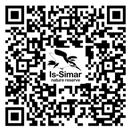
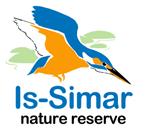

Qanfud Atelerix algirus
We have very few wild mammals in Malta, and most of them were brought over by people from overseas. One that probably arrived by boat from North Africa is the Algerian Hedgehog, but nobody knows when this happened. It’s pretty clear, however, that it was a long time ago because the hedgehog is today widespread in Malta as well as in Gozo. Secretive in habit and largely nocturnal, it goes about its business, foraging for snails, slugs and other small animals in fields, gardens and roadsides. We all know about the hedgehog’s trick of rolling into a ball of spines when danger looms. Sadly, this defence mechanism proves invariably fatal when the danger is an oncoming car, as evidenced by the hundreds of casualties that litter our country roads. So it’s nice to know that car-free oases like Simar exist for this cute customer.
Squacco Heron

Agrett Isfar Ardeola ralloides
Herons and egrets are generally biggish birds. The goliath heron can snap a worm off an adult human’s head from a standing position (don’t try this at home!). But not all in the heron family are this big: the Squacco Heron is one of the smaller members of this long-legged, long-necked and long-billed bird family. All these features come in handy to spear frogs, fish, etc. from shallow lakes and riversides. Squacco Herons are migratory, so in Malta they occur in spring and autumn. They are not hard to identify in flight, with brownish yellow body, brilliant white wings and that rather languid flight. They like to travel in groups and, like other herons, they look for watery places in search of their aquatic prey. A wetland like Simar Nature Reserve is great place to watch out for Squaccos.
The Chaste Tree is as beautiful as it is scarce. The reason for its scarcity is because its favourite habitat – damp water courses – is in short supply in Malta, though less so in Gozo, where the species is in fact rather more common. Despite its name, the Chaste Tree is more a shrub than a tree, though it can grow a good 3m tall. Its star-shaped leaves are reminiscent of cannabis leaves but the plant is not related – indeed, its seeds were formerly used to make anti-aphrodisiac concoctions, which incidentally explains the ‘chaste’ in its name. The Chaste Tree is deciduous, shedding its foliage for winter and looking quite dead for a couple of months! It makes up for this in spring and summer by the profusion of lilac flowers, much beloved by bees (especially bumblebees), butterflies and other pollinators.




Birds have fascinated humans since long ago and birdwatching has become a popular hobby in many countries, particularly in Europe. Since BirdLife Malta was founded, originally as the Malta Ornithological Society, Malta has always had its fair share of birdwatchers and birdwatching has always been core in BirdLife Malta’s work.
But why are birdwatching and birdwatchers important for bird and nature conservation organisations?
Nature conservation, be it in the form of government lobbying or direct conservation actions such as habitat restoration, is most effective and successful when backed by science. And science is only possible when data is available. So effectively, when out birding and logging bird sightings in online platforms such as e-bird, birdwatchers are collecting valuable data that can be used by scientists to come up with arguments for conservation. This is even more true when birding is done in a coordinated and standardised manner, often referred to as surveying or monitoring. Furthermore, trends in bird populations often reflect the general state of nature, making birdwatching an even more important conservation tool.
Additionally, birdwatchers are often so connected to the birds they enjoy watching, that they are far more likely to engage in conservation actions (e.g. restoring natural habitats, protesting, joining NGOs, donating, signing petitions) than people who never experienced nature. It is not a surprise that groups of birdwatchers often come together and form NGOs to protect species or areas they are particularly fond of.
Thanks to digital cameras and social media, bird photography has recently gained more popularity in Malta, in particular with the older generation. On the other hand there is a very noticeable gap in younger generations with not many young birdwatchers coming up, possibly due to the fact that these generations have been brought up with very little time in the outdoors and maybe too much screen-time.
This is why in early 2022 we set up the Young Birders Club (within Klabb Ħuttaf, our junior section) for children aged 8 to 13, to further complement our informal education programmes. The mission of this new club is to foster a passion for birds and nature in children such that a new generation of birdwatchers, nature enthusiasts and conservationists is secured for the near future.
Since then, we have taken members on regular outings to experience the best of Maltese birding, choosing the right times and locations to make the most of the different seasons. We have organised walks in different parts of the Maltese Islands, birding at BirdLife’s nature reserves and other hotspots to watch migrating raptors, and we also chartered boat-trips to enjoy wildlife out at sea. Memorable moments at sea included watching rafting shearwaters at sunset beneath Ta’ Ċenċ cliffs, watching
“Birdwatchers are often so connected to the birds they enjoy watching, that they are far more likely to engage in conservation actions than people who never experienced nature”

“The mission of this new club is to foster a passion for birds and nature in children such that a new generation of birdwatchers, nature enthusiasts and conservationists is secured for the near future”
and friends. Birdwatching also sharpens your senses, improves concentration and is a very good way to get physically active. The club is also giving these children new friends that share the same passion for nature.
scores of Black Terns and European Storm-petrels around the Marsaskala fish farms in summer and, most recently, enjoying playful Bottlenose Dolphins and relaxed Loggerhead Turtles. Our club activities often include bird ringing, a very engaging way for people to observe birds up close. We were lucky to watch species like European Nightjar, Eurasian Scops Owl, Hoopoe and European Bee-eaters being ringed at the Kemmuna Ringing Station. Recently we also turned the visitor centre at Salina Nature Reserve into a biology lab where the children learned about owl diets and actually had a go at dissecting owl pellets.

Birdwatching also exposes children to a variety of skills beyond actual watching and identifying birds. Birding teaches you about weather, geography, ecosystems and how evolution shaped the species we know today. Most of the children are so intrigued by the wildlife they see during outings that they spend hours reading about it at home and sharing their experience with family
Through the Young Birders Club we want to give children the opportunity to experience nature first-hand, and while we hope they all stick to the hobby and become the new generation of Maltese birders, we also hope they will all be ready to stand up to be counted and be a voice for birds and nature when needed in the future.

“The children are so intrigued by the wildlife they see during such outings that they spend hours reading about it at home and sharing their experience with family and friends”

 WORDS Nicholas Galea BirdLife Malta Young Birders Club Leader
Bird ringing demonstration
Ray Galea
Bottlenose Dolphins sighted during a recent boat trip
Enjoying the spectacle provided by Scopoli’s Shearwaters – another memorable experience
Aron Tanti
Jonathan Pullicino Gauci
Seawatching from Qammieħ Point
Ray Galea
WORDS Nicholas Galea BirdLife Malta Young Birders Club Leader
Bird ringing demonstration
Ray Galea
Bottlenose Dolphins sighted during a recent boat trip
Enjoying the spectacle provided by Scopoli’s Shearwaters – another memorable experience
Aron Tanti
Jonathan Pullicino Gauci
Seawatching from Qammieħ Point
Ray Galea
Nature Guardians returns for a special summer edition! In this popular course, a group of budding young naturalists immerse themselves in handson nature learning and action at BirdLife Malta’s nature reserves. Two courses are on offer: one in July and one in August-September. Each course will consist of 13 sessions, held three times a week (Monday, Wednesday and Friday) from around 5pm to 8pm. The course will again take participants to our nature reserves at Salina, Simar, Għadira and Foresta 2000.

The Nature Guardians summer edition promises something different in terms of nature appreciation. Group size will never exceed 20 children.
To register your interest or for further details please send an email to mark.gauci@birdlifemalta.org.




The probes that the sonde uses to measure the parameters and what results can be seen in real time
An important work done at our nature reserves is the testing of water quality. Ensuring water health and monitoring the parameters are very important as these can affect reserve wildlife, as some species can be more sensitive to certain parameters than others.

The main water parameters focused on at the reserves are temperature, pH, dissolved oxygen, salinity, nitrates, chlorophyll, turbidity and phosphates. Changes or spikes in any of these parameters can have very negative effects on the ecosystems, particularly if these changes are prolonged.
There are various ways of testing these parameters but the main method is through the use of a multi-parameter sonde. As the name implies, this instrument measures various parameters. The sonde can measure all the above parameters, except phosphates. It also has trouble reading very high salinity and can only read up to a certain level. So when salinity is very high, as in the summer months, we use a refractometer, which can measure brine. This is especially the case at Salina as the salinity can sometimes rise to more than six times that of the sea.

As stated previously, any changes to the normal parameters of a body of water can have catastrophic effects on the ecology of the area, particularly if it is home to species that are very sensitive to the conditions of their surroundings.
As all species are linked through food webs and food chains, if one species is affected to the point where it can no longer exist in that area, it is not always possible to predict the cascade effect that could occur further down the line. A large die-off of a species caused by an averse environmental condition could cause a series of other problems. For example, spikes in nitrogen can lead to algal blooms. When the algae die and start to decompose, they use up all the oxygen in the water, starving other aquatic species of oxygen and causing them to die. This is called eutrophication and can be devastating to aquatic life. This is just one example that demonstrates the importance of monitoring water quality. Without this testing, it is hard to predict how changes in each parameter will affect species both biochemically and physically, and how they in turn will affect other species sharing the food web.

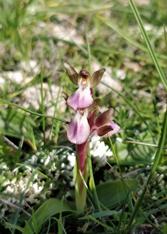
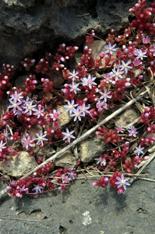
The northern part of Malta is characterised by a sequence of parallel flat-topped ridges and flat-bottomed valleys, all tending from a west-southwest to east-northeast direction. They were formed not by erosion but by faulting, which is the result of fractures between blocks of rocks. Just north of Simar Nature Reserve stands Bajda Ridge. It is flanked between two valleys, Pwales Valley on one side and Miżieb Valley on the other. A walk along this ridge offers not only spectacular views, but also a wealth of historical remains and an abundance of plants and animals.

The surface of the ridge, composed entirely of exposed Upper Coralline Limestone, is dominated by one of the finest garrigue habitats in our islands. Rainwater rock pools form in some of the low depressions in the winter months. Pwales Valley is heavily cultivated, making its landscape look rather monotonous. Miżieb Valley is much narrower than Pwales Valley; it contains more trees and only parts of it are cultivated. There are also small isolated patches of cultivated land in the garrigue. In the midtwentieth century, Bajda Ridge was chosen as the site for a major afforestation project. Thousands of Aleppo Pines, eucalyptus and Olive trees were planted. These today form the Miżieb woodland. Many trees remained stunted due to the lack of soil and exposure to winds. Even so, natural regeneration of Aleppo Pines is evident on the garrigue slopes of Miżieb Valley, and despite the lack of soil, many saplings are developing into mature trees.

Blue Stonecrop blooms with the smallest of flowers. Life in the garrigue seems to sprout from every crack in the rocks. When visiting the area, spend some time taking pictures of the tiny flowers, even with your mobile phone. The enlarged images on your screen will surprise you with so many hidden details.
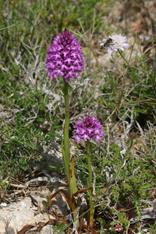
The dominant shrubs are Mediterranean Thyme, Olive-leaved Germander, Lentisk and Olive-leaved Buckthorn. From late winter onwards look out for the orchids. Some, like the Common Pyramidal Orchid are easily spotted because of their size and eye-catching flowers. The smaller ones, such as the Fan-lipped Orchid, are harder to find but certainly worth the effort. Common annuals provide splashes of colour with their abundant flowers, making the landscape more interesting and dynamic. Red Campions carpet whole areas with their delicate flowers, and


Resident birds include Sardinian Warblers, Zitting Cisticolas and Blue Rock-thrush. From mid-autumn till early spring, the garrigue hosts various wintering bird species such as Meadow Pipits, Black Redstarts and Skylarks. Robins and Blackcaps can be heard calling from the wooded parts of the ridge. During migration, the ridge offers a good vantage point to observe herons and raptors among others. Avoid the wooded parts during migration, since they are heavily frequented by hunters.

Skinks and geckoes find shelter in the rubble walls. As the weather gets warmer, one may also encounter the Western Whip Snake or Leopard Snake. Flowering plants attract pollinating insects. If you go walking in this area, enjoy the breathtaking scenery, but do stop from time to time to listen to the birdsong, and to scan the habitat for these small but fascinating creatures.
As if all this were not enough, the area boasts a concentration of historical (and prehistoric) sites. You will find well-preserved ancient apiaries, menhirs, remains of a Roman road, tombs, bronze age cart ruts and troglodyte caves.





Sadly, the beautiful views are being marred by the relentless and uncontrolled building development, especially from Xemxija, while ugly highrise apartments now also dominate the Mellieħa skyline. One can only hope that common sense will prevail and that this site will be afforded the proper protection it deserves.

2 Dec 2022 BirdLife Malta’s Annual General Meeting (AGM) for 2022 was held at Salina Nature Reserve. This year’s AGM was special as it marked the end of our 60th anniversary year. The event started off with a moment of memory-sharing from past presidents and directors, followed by presentation of the annual reports. BirdLife Malta President Darryl Grima concluded the meeting with an address followed by a Q&A session.
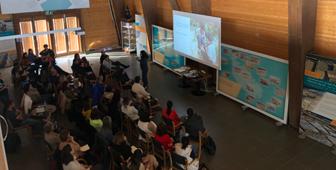
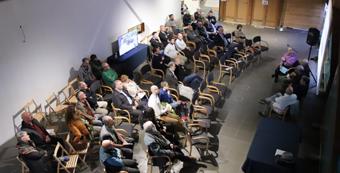
3 Dec 2022 Following the Court’s annulment of the secret agreement through which Miżieb and Aħrax woodlands had been handed to FKNK, we joined the Spazji Miftuħa coalition of ENGOs to celebrate this victory. We enjoyed the beauty of the area, freshly returned to the public, with a walk through Miżieb. We met at Simar Nature Reserve and proceeded to the woodland, then had a picnic in this rare habitat.
4 Dec 2022 At the beginning of December, the BirdLife Malta Events & Activities Group led a nature walk in Gozo for members. The circular walk started in Qbajjar and proceeded through Xwejni Bay, Wied il-Mielaħ, Wied il-Għasri, then Żebbuġ and back to Qbajjar. The event concluded with an optional lunch at a restaurant in Xlendi.

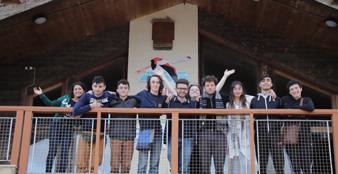
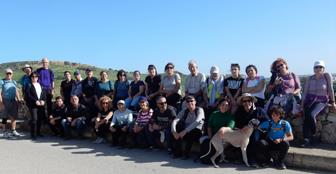
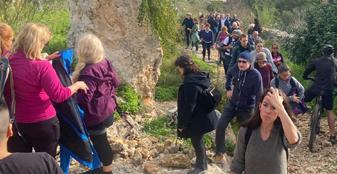
7 Dec 2022 Our yearly Dinja Waħda (DW) Coordinators Day was dedicated to the Dinja Waħda+ programme and the new online action guide. At this event, we also launched our brand new DW website. Thanks to the new centralised system, teachers can now access DW activities, upload evidence of activities and receive their well-deserved points. This is a huge step forward for us, and we were happy to celebrate with all the school coordinators.
11 Dec 2022 Salina Nature Reserve hosted a Christmas celebration for young people! We had a great time learning about wintering birds and creating nutritious cookies for birds. Gulls resting in the salt pans gave us some great birdwatching, after which participants played the BirdLife Malta Memory Game and learned the name of our breeding birds. At the end of the event, everyone enjoyed a hot chocolate and snacks. The event was part of the It’s Time Erasmus project event series and it was organised with help from the BirdLife Malta youth group.
17 Dec 2022 BirdLife Malta’s education team welcomed kids from Klabb Ħuttaf, our junior section, and their parents at Simar Nature Reserve for a Christmas celebration in nature. We learned a lot about Simar’s plants and animals, and about different Christmas traditions from all over the world. Kids had a fun Christmas trivia, enjoyed a spot of craft making beautiful snowflakes, robinshaped decorations and winter castle cards. We finished the event with a quest around Simar and received some sweet gifts from Santa.

ceremony. Meanwhile we have now launched our spring edition of Nature Guardians.
14 Jan 2023
Most White Wagtails that winter in Malta gather every evening to sleep in the Ficus trees in and around Great Siege Square in Valletta. Every year since 1985 BirdLife Malta has monitored this special place by conducting a roost count. This year, 16 volunteers counted 11,192 White Wagtails. A big thank you to the volunteers who manned this year’s White Wagtail Roost Count.
Three months and 12 sessions of pure fun and learning down the line, BirdLife Malta’s first-ever Nature Guardians course came to an end at the start of the year. No task was too much for our 10 young Guardians as they quickly got their hands dirty building bug hotels, propagating rare flora, sampling water at the nature reserves, creating hedgehog habitat and learning about bird ringing and birdwatching. It was all smiles at Salina Nature Reserve on 7 January as the young participants attended the certificate presentation

27 Jan 2023 BirdLife Malta and Bye Bye Plastic Bags Malta held a workshop at Verdala International School to transform garbage into works of art. The friendly and creative atmosphere helped unleash the participants' artistic potential, resulting in the creation of several species of birds. The winners were determined by a vote at the end of the workshop, and they were awarded a free BirdLife Malta membership for one year. The workshop was successful in promoting environmental awareness and creative recycling.

12 Feb 2023 Our Events & Activities Group collaborated with Fondazzjoni Paulus for a nature walk around the Rabat countryside as part of their Rabat AGAPE Festival. Despite a recent storm, over 120 people joined us on the 8km trek where participants learned about the flora and fauna. The walk began at St Paul’s Square in Rabat and proceeded to Nigret past San Kataldu Chapel, Wied Ħażrun, Lunzjata, Santa Katarina Chapel and back.
8 Apr 2023
Join our annual Easter event featuring Easter egg hunts at Foresta 2000 and nature-based activities at Għadira Nature Reserve, including face painting, nature crafts, and birdwatching.
16 Apr 2023
Attention all young nature enthusiasts! Get ready to explore the stunning landscapes of Comino with us. This exciting event includes a tour of the ring station, birdwatching, a delicious picnic, and so much more. No matter your level of experience, everyone is welcome to join in on the fun and make some unforgettable memories.
21 Apr 2023
BirdLife Malta will join Din L-Art Ħelwa for a seabird walk at Dwejra in Gozo, where Scopoli's Shearwaters and Yelkouan Shearwaters nest. The event will start at 6.30pm at Dwejra Tower, with a tour of the newly-refurbished tower and a short presentation on seabirds in the area. Participants will then take the 1.2km walk on rough and rocky paths along the cliffs to listen to the shearwaters.
21-24 Feb 2023
BirdLife Malta's nature reserves team visited some nature reserves in the United Kingdom managed by our UK BirdLife partner, the Royal Society for the Protection of Birds (RSPB). During their visit, they discussed visitor engagement, conservation work, challenges and potential solutions with management team members. The team also visited the offices of BirdLife International in Cambridge and met CEO Patricia Zurita and Vice President of Regions and Partnership Martin Harper. The visit was made possible thanks to a grant from the the British High Commission in Malta. The team is now implementing some of the tips acquired to improve the visibility and management of our own nature reserves.
29 Apr 2023
14 May 2023
For the first time since 2019, BirdLife Malta will again set up stand at the Science in the Citadel festival in Gozo. A great opportunity to meet the public and tell them about our work and lead exciting games and quizzes. See you in Gozo!
26 Feb 2023

The BirdLife Malta Events & Activities Group organised a four-hour circular walk through the valleys of Qormi and Żebbuġ. The route passed through Wied iċ-Ċawsli, Wied il-Kbir, Wied Ħesri, Wied Qirda and Wied is-Sewda, and included a visit to the unique Għar tasSlaleb cave (also known as Għar Ħanżir) and the church of the Visitation of Our Lady. Around 80 participants enjoyed the beautiful countryside, particularly Wied Qirda.
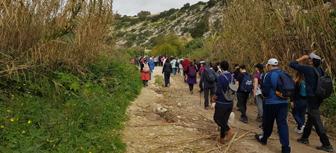
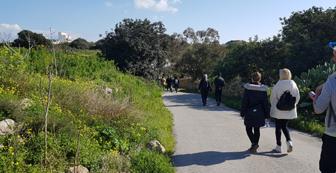
26 Mar 2023 BirdLife Malta led a group of about 60 individuals on a scenic 7km walk through northern Malta for this year’s Walk for Nature. People of all ages participated, learning about the local flora and fauna while appreciating the stunning natural landscapes. Walk for Nature 2023 raised €900 to purchase a tracker to study the migration of Turtle-doves. See you next year to continue showing love for nature and making a difference together!
BirdLife Malta will lead a 5km birdwatching trek at Pantani Cuba e Longarini Nature Reserve, near Siracusa (Sicily). The reserve boasts over 60 species of waterbirds, including herons, storks and flamingos. The trip also includes a lunch. Want
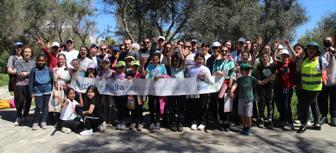
The spring hunting season will soon open again, and the European Turtle-dove (Gamiema) will probably be a target species again. The Turtle-dove – a species classified worldwide as Vulnerable to Extinction – had been enjoying a springhunting moratorium since 2017, but last year the government lifted the ban and reopened the hunt. How long will the senseless slaughter go on?
